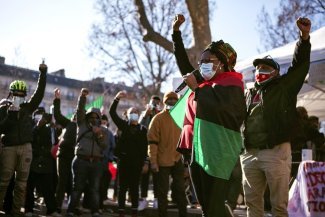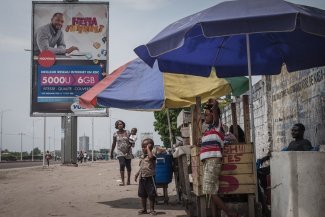Internally, Iran has overcome the pressure of sanctions, although the damage they caused did force it to sit at the negotiating table, resulting in the June 2015 nuclear agreement. In this photo, the UN Security Council meets in New York to discuss the Iranian nuclear programme and possible sanctions on 24 March 2015.
For Saudi Arabia today, Iran is the embodiment of all evil. Determined to preserve the dominance of Sunni Islam, Riyadh is not only using all possible means to prevent its neighbour from emerging as a possible regional leader, but is also urging Washington to do the same, and even align with Tel Aviv, which sees the rule of the Ayatollahs as a direct threat to its security. Tehran, which has managed to maintain its controversial revolutionary regime for 38 years and has hugely increased its influence in the Middle East, is looking beyond Riyadh, which it sees as a weak player sheltering behind the umbrella of the United States.
But it hasn’t always been this way. Until 1979 both countries had sustained normal relations and stood out as the faithful allies of Washington in the region. Until then the Shah, Reza Palevi, had been a strong pro-Western bulwark, while the representatives of the House of Saud were just as eager to maintain the 1945 agreement between President Franklin D. Roosevelt and the then monarch, Abdelaziz bin Saud.
Everything changed, as it is well-known, when Ayatollah Ruhollah Khomeini entered the scene, as the leader of a revolution that set up the welayat-e-faqih regime in Iran, and announced that he intended to expand the model to the rest of the Muslim world, characterising the West (and first and foremost the United States) as the ‘Great Satan’ that had to be expelled from the region. This momentous shift amounted to an outright questioning of the status quo that had allowed dark regimes like the Saudi rulers to remain in power together with the other so-called ‘corrupt monarchies of the Gulf’, as the defenders of the geo-strategic and geo-economic interests of Washington and the other Western capitals.
In response, Washington immediately turned its attention to Iraq, making Saddam Hussein its new ally and the main battering ram to derail Khomeini’s plans. Not only did the First Gulf War (1980-1988) fail to achieve its aims, it also ended up fostering a new monster, Hussein himself, who invaded Kuwait in August 1990, adding to the instability that still exists today.
Meanwhile, Riyadh called on the rest of its decidedly weak neighbours, creating the Gulf Cooperation Council (GCC, 1981) as a front united only by their more or less forced submission to Saudi Arabia and by each members’ interest in preventing Tehran from becoming the regional hegemonic power. For its part, the United States succeeded in winning approval in the UN Security Council for successive rounds of sanctions against the regime which at that point had already become an international pariah, both for its interference in the affairs of its neighbours and its worrying nuclear programme.
The barely disguised aim was (and continues to be) to provoke the fall of the regime, strangling it economically until the people became so frustrated that they would bring about its collapse.
The military option lost weight, meanwhile, as Washington became convinced that it could not open a third front in the region after the failure of its military campaigns in Afghanistan and Iraq. Israel, for its part, had no choice but to admit it could not undertake alone a task that was beyond its means, while Saudi Arabia saw the futility of the attempts to neutralise their rival, as not only were they not echoed in the White House, but also they led to a nuclear agreement that allowed Iran to return to the international stage.
Riyadh, more protected; Tehran, more resilient
Despite the oppression from all sides, it was clear that the Iranian regime had managed to resist pressure and maintain its momentum, avoiding destruction and openly competing for regional leadership. Internally, Iran was able to overcome the harsh punishment inflicted on it, although the damage caused forced it to sit down at the negotiating table, leading to the nuclear agreement of June 2015. With enviable resilience, and by using internal repression whenever it considered it necessary, the regime has succeeded in keeping its own population under control all these years and built up considerable military power, include a missile arsenal and its pasdaran (the Iranian revolutionary guard) who have proved beyond doubt their high operational level, as well as creating a controversial nuclear programme (currently frozen, but not eliminated).
At the same time, aware that it is in the sights of very powerful enemies, Iran has sought to retaliate strongly against those who want to bring about its downfall. It believes this is its best line of defence against Saudi Arabia and its other enemies.
That is why Iran is so keen to make the most of those who share its Shi’ite beliefs and to exploit the marginalisation of those who feel left out by their rulers in Lebanon (supporting Hezbollah), in Syria (focusing on the Alawite regime of Bashar al-Assad), in Iraq (approaching Shi’ite Arabs who are more than 60 per cent of the population), in Yemen (supporting the Houthi minority), in the Gaza Strip (associating with Hamas, although their religious profile is Sunni) and even in Saudi Arabia itself and Bahrain (where marginalised Shi’ite populations live).
But there is no guarantee of success in this venture, with so many rushing to try every option to neutralise its rebellious stand. Washington is first in line, and made it very clear with Donald Trump’s first trip abroad (in May 2017) that it was handing over to Riyadh the task of restoring and maintain regional stability, confirming its wish to continue arming its ally and the other members of the GCC, as well as looking the other way whenever human rights are violated or international laws breached. And that message has just been reinforced (on 8 May) with the condemnation of the nuclear agreement, opening the door to an escalation of tension that could well lead to renewed outbreaks of violence.
Riyadh meanwhile – notably Mohamed bin Salman, hereditary Prince and Minister of Defence – has been quick to take advantage of the situation to consolidate its leadership of the anti-Iran front. Along similar lines, the idea of an “Islamic NATO” is gaining ground, building on the Peninsula Shield Force created in 1984 by the GCC.
A good example of this is the Joint Gulf Shield 1 military manoeuvres carried out in the country’s eastern province from 21 March to 16 April, in which over 20 countries took part, including a small Qatari contingent. Tel Aviv, meanwhile, is already daring to make direct attacks on Iranian targets in Syria, trying to provoke an overreaction from the Iranians to justify a large-scale attack.
It is in nobody’s interests to provoke direct confrontation in this duel being fought by Riyadh and Tehran. The preferred alternative is indirect intervention, manipulating local allies to create tensions where interests differ. Currently Riyadh is heavily protected – by Washington and by the other GCC countries and even Tel Aviv. But Tehran, while enjoying less protection – although Moscow is getting closer to it all the time – has more military power, considerable human resources and an iron will to keep up its resistance, as it has proved for decades. The end of this rivalry is still a long way off.










